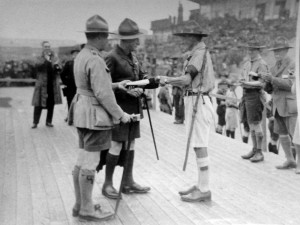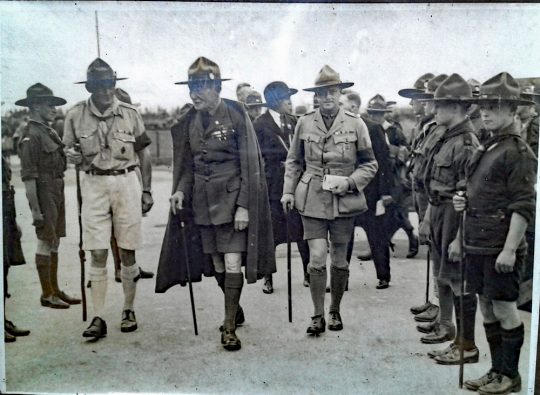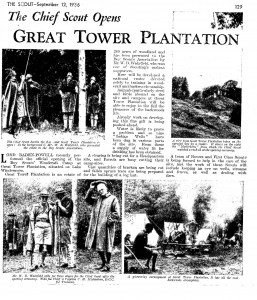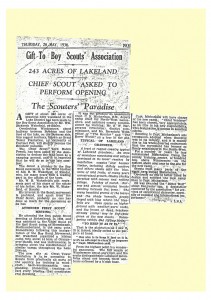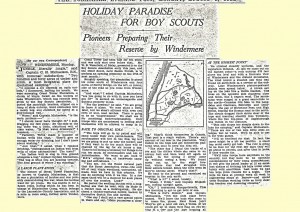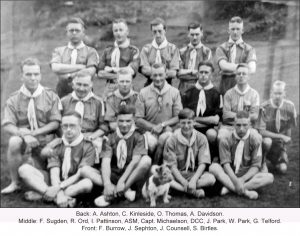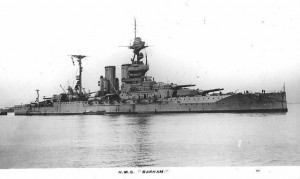Capt. Michaelson features in a number of reports on Scouting activity from the 1920’s to the 40’s. He was carrying out leader training at Blakeholme, a property on the east side of Lake Windermere (currently within the Hill of Oaks Lodge and Caravan Park) and was also, later, the ‘Verderer’ at Great Tower Scout Camp when this land was given to the Scout Association in 1936.
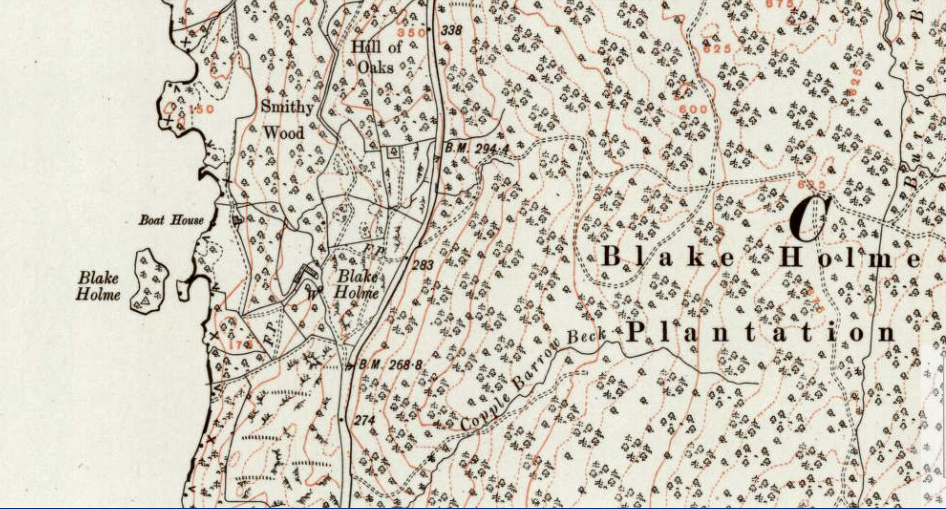
Charles Herbert Michaelson was born on 8 Jan 1883 at High Street House, Lancaster.
Lancaster Gazette 10 January 1883:
BIRTH. On the 8th inst., at High-street House, Lancaster, the wife of Captain Michaelson, 1st Battalion Royal Inniskilling Fusiliers, of a son.
Baptism: 11 Feb 1883 St Mary, Lancaster
Charles Herbert Michaelson – [Child] of George Herbert Michaelson & Sarah Mary Rachel
Born: 8 Jan
Abode: High St. House
Occupation: H. M. Service Milt.
Baptised by: J. Allen, Vicar
Register: Baptisms 1882 – 1893, Page 30, Entry 234
Source: LDS Film 1526200
His father, George Herbert Michaelson was born 3 December 1849 on the Isle of Barrow.
Baptism: 21 Apr 1850 St Mary, Dalton in Furness, Lancashire, England
George Herbert Michaelson – Son of Thomas Yates Parker Michaelson & Jane*
Abode: Isle of Barrow
Occupation: Esquire
Baptised by: J. Park
Register: Baptisms 1848 – 1853 from the Bishop’s Transcripts, Page 38, Entry 300
Source: LDS Film 1040304
THOMAS YEATES PARKER MICHAELSON
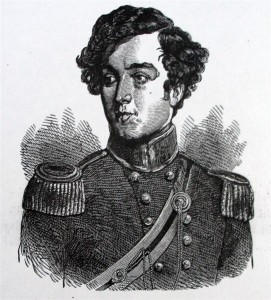
“The late Mr T Y P Michaelson, whose portrait we here present to our readers, was born at the old hall [Barrow Island] in April 1814. His education was commenced at Shrewsbury School, under the late Dr Butler, from whence he was afterwards removed to Trinity College, Cambridge. From the time of his coming of age he resided on the island, and soon after he received his commission in the Furness Troop of Yeomanry Cavalry. In 1841 he married Jane *, eldest daughter of the late Charles Gibson, Esq., of Quernmore Park, near Lancaster. and shortly after was qualified as a Justice of the Peace for the Division of Lonsdale North of the Sands. Thomas Michaelson was an active magistrate in a district which then, for many years, contained no other within twelve miles of Barrow. He was also a deputy-lieutenant of the county, and a zealous supporter of the Conservative interest.
His death, from a lingering decline, at the comparative early age of 41, occurred in the Isle of Barrow, on the 24th July, 1855, leaving a widow with three sons and two daughters to mourn his loss. His remains were interred at the east end of Walney church-yard. Within the neat enclosure that contains his grave a stone has been erected …” [details taken from ‘Furness Past and Present, volume 2’, by George Markham Tweddell & Joseph Richardson, 1870].
The Lancaster Gazette and General Advertiser, for Lancashire, Westmorland, &c. Saturday, April 23, 1814:
BIRTHS. On Thursday last, the Lady of Robert Michaelson, Esq of the Isle of Barrow, in this county, of a son and heir.
Baptism: 14 May 1814 St Mary, Lancaster, Lancashire, England
Thomas Yeats Parker Michaelson – Son of Robert Michaelson & Millicent # see below
Born: 21 Apr 1814
Abode: the Isle of Barrow in the Parish of Dalton
Occupation: Esq’r
Baptised by: J. Rowley, Curate
Register: Baptisms 1813 – 1818, Page 67, Entry 535
Source: LDS Film 1526146
# Millicent died in Brompton in London and was buried in Broadstairs on 16 Sept 1822. Robert wrote his will on 23 Sep 1822 appointing as trustees and guardians his good friends James Machell of Pennybridge, James Satterthwaite of Lancaster and Widow Elizabeth Postlethwaite of Grange. The will was witnessed by Wm Tribe of Worthing, Attorney at Law, and by Robert Hackett servant to Robert Michaelson. It is clear that Robert M knew he was dying. He was buried at Broadwater St Mary on 2 Oct 1822. The will was proved at London on 17 Oct 1822. Robert left all his household goods, furniture, plate and wines, to his eldest son Thomas Yeates Parker Michaelson, then aged 8. On 19 May 1823 all these household goods were offered for sale prior to letting out the large Mansion house on Barrow Island on May 25th. The list of goods for sale is very impressive. (Lancaster Gazette 26 Apr 1823)
Memorial in Cartmel Priory:
“In memory of Robert Michaelson Esquire of Old Barrow Isle Low Furness, who died
at Worthing in the County of Sussex, September 23rd 1822, aged 30. Also of Millicent
his wife, daughter of John Satterthwaite of Rigmaden Park, who died at Worthing Sept
11th 1822.”
The Michaelsons were evidently long term residents of North Lonsdale – (The Lancaster Gazette and General Advertiser, for Lancashire, Westmorland, &c. Saturday, August 05, 1809) DIED. Lately, at the island of Old Barrow, near Walney, Robert Michaelson, Esq. aged 79. – His remains were interred in Cartmel Church, on the 25th ult.
Memorial in Cartmel Priory (south transept, aisle furthest west):
Under this stone
lie the remains
of
Robert Michaelson
late of Old Barrow in the
County of Lancaster
Esquire
who departed this life
the 18th day of July 1809
in the 80th year of his age.
Further reading on the Michaelson family history in the Cartmel Peninsular can be found here (Nigel Mills)
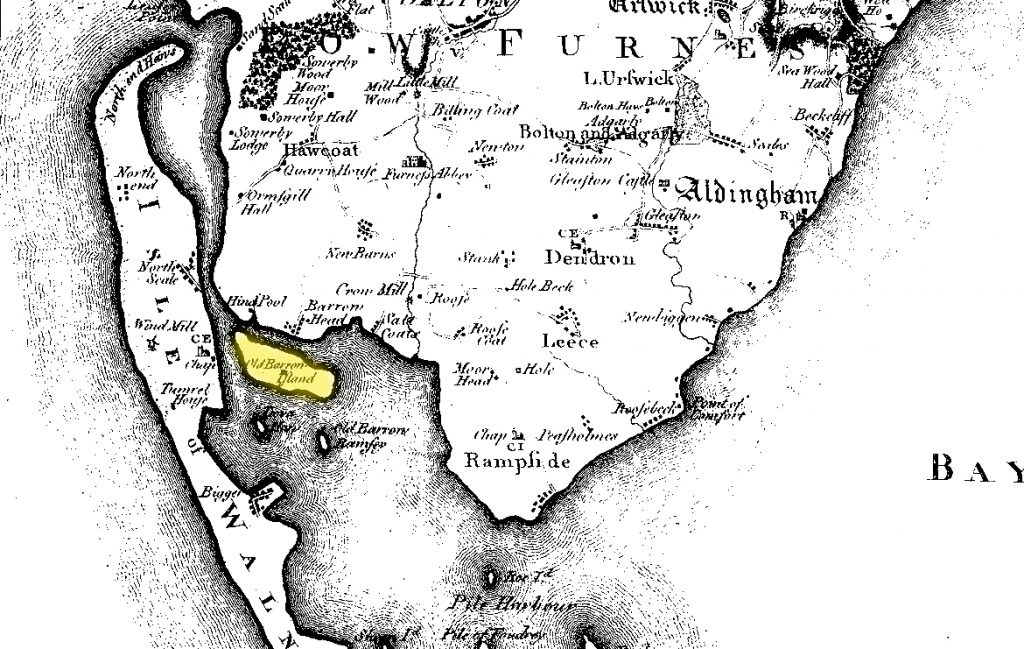
ULVERSTON HUNT.
THE ANNUAL HUNT, at Ulverston,
will commence on MONDAY, the Sixth of
NOVEMBER, and continue the whole week.
ROBERT MICHAELSON, Esq. Mayor.
Ordinaries as usual, and Ball on Wednesday.
Ulverston, 17th Oct., 1820.
Lancaster Gazette 26 Apr 1823:
“DESIRABLE RESIDENCE, TO BE LET, BY PRIVATE TREATY,
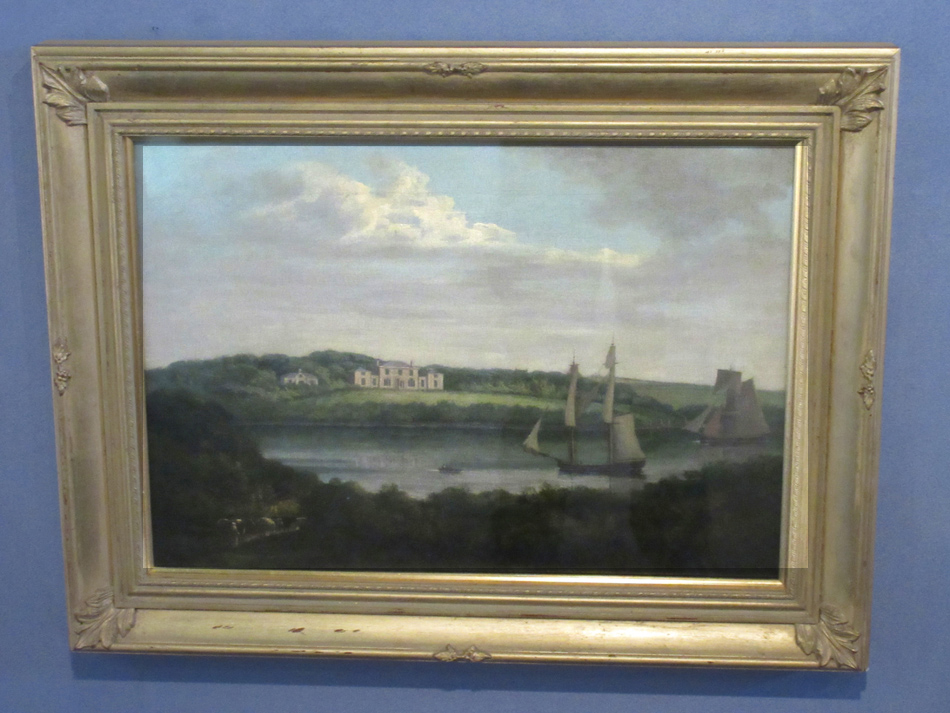
And may be entered upon at any time after the 25th May, 1823.
A modern-built MANSION-HOUSE situate at Barrow Isle, near Ulverston, in the county of Lancaster, late the residence of R. Michaelson, Esq. deceased, with Gardens, Hot-house, Stables, Coach-house, and every requisite convenience.
The premises are in a healthy situation, near the Western coast, separated from the main land by a narrow estuary, which is passable on foot for six hours together; and are well sheltered by full grown woods and several young thriving plantations.
The house consists of a dining-room, 18 feet by 16½ feet; a drawing-room, 19 feet by 17 feet; library, billiard-room; housekeeper’s-room; butler’s-pantry; servants-hall; gun-room; store-room; kitchen; and all suitable offices on the ground floor, with very good cellars underneath; and six good bed-rooms (two of them with dressing-rooms attached) besides several smaller rooms, on the first floor.
With the house may be had about 30 acres (or less, if desirable of good Pasture and Mowing Ground.
Also, to be sold HOUSEHOLD FURNITURE (long list) includes “furniture of the celebrated manufacture of Messrs. GILLOWS . . . “
There is another painting of the house on the BBC Your Paintings website.
The Lancaster Gazette and General Advertiser, for Lancashire, Westmorland, &c. (Lancaster, England), Saturday, December 04, 1841
Local Intelligence
The good old town was agreeably excited on Thursday last by the “gay wedding” which took place on that day at our parish church. We, of course, allude to the nuptials of T. Y. P. Michaelson, Esq., of the Isle of Barrow, with Miss Gibson, daughter of the late and much lamented Charles Gibson, Esq., of Quernmore Park. The bridal party were accompanied to the church by an unusually long train of carriages, comprising Lady Dallas’s beautiful equipage of four whites, the chariots and four of R. F. Brockholes, Esq., and the bridegroom; the carriages of J. C. Satterthwaite, Esq., Mrs. S. Harrison, Mrs Gibson, J. P. Machell, Esq., E. G. Hornby Esq., G. Jacson, Esq. After the ceremony, a large party partook of an elegant breakfast at the residence of Mrs. Harrison, in High-street, and in the afternoon the bride and bridegroom, in a carriage and four (the headstall of each horse decorated with the Lancashire rose), drove off for the Isle of Barrow. The appearance of so many handsome carriages in the streets, caused a good deal of bustle in the town, and a considerable number of inhabitants attended at the church.
* Jane Gibson was born 4 March 1821 at Quernmore, died July 31st 1887. She was a daughter of Charles Gibson, Esqr. Junr. of Quernmore Park (1790- died July 29th 1832). His father, Charles Snr., bought the estate in 1793 for £21,000.
Lancaster Gazette 18 October 1851:
THE ROYAL VISIT TO MANCHESTER.
In the evening there was a grand party at Worsley, comprising all the nobility and gentry of the neighbourhood, besides the distinguished visitors who were guests at the Earl of Ellesmere’s.
Amongst the presentations to her Majesty were Captain Michaelson, (etc) and the other officers of her Majesty’s Royal Lancashire Yeomanry Cavalry.
Thus concluded her Majesty’s memorable visit to the county palatine of Lancaster. Her Majesty, Prince Albert, and the royal family returning to Windsor Castle on Saturday.
Lancaster Gazette 03 August 1887:
DEATH. On the 31st July, at High-street House, Lancaster, Jane Elizabeth, widow of the late T. Y. P. Michaelson, Esq., of the Isle of Barrow, aged 65.
INSCRIPTIONS IN LANCASTER CHURCH.
On the east wall of the north aisle of the chancel : —
In loving Memory of Jane Michaelson Born March 4th
1821 Died July 31st 1887
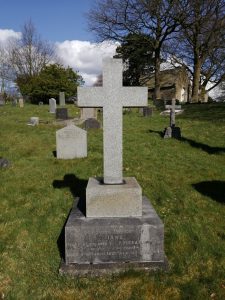
(From Contrebis) Charles Gibson, the elder, died on 16th July 1823, leaving a widow. His son Charles inherited the estate but he died 29th July 1832, aged 42 years. The entire estate was put up for auction in 1842 but not sold. It was then sold privately to William Garnett of Salford, for £58,500, with the sitting tenants on existing leases – Lady Dallas remained in residence at the Hall until 1st. April 1843, dying in London 1 December 1847.
Mannex & Co. 1851 Directory of Westmorland with Lonsdale and Amounderness in Lancashire.
Old Barrow Island, in this township, lies near the main land opposite Barrow, which is a seaport, in Pile harbour, whence great quantities of iron ore, coal, &c. are shipped from a pier completed in June, 1846. Two new cranes have been fitted up here in this year (1849) by the railway company, who also erected a station house and a strong engine house, a short distance from the village, in 1846, in which year the line of railway from Broughton to Dalton was opened. Mr. J. Dix is the station master. A Building Society was established at Barrow in 1848, on much the same principles as the generality of such societies in other parts of the kingdom. The population of Barrow has greatly increased within the last twenty years. On old Barrow Island is a handsome mansion called Old Island Hall, the seat and property of Thos. Y. P. Michaelson, Esq., who is also owner of the whole of the island. This mansion occupies a pleasant situation near the shore, and is finely shaded with trees.
Westmorland Gazette 14 March 1857:-
OPENING OF THE NEW SCHOOL AT WALNEY ISLE.
The school at Walney Island, built by Mrs. Michaelson, of the Isle of Barrow, in memory of her late husband, T.Y.R. Michaelson, Esq., was opened on Wednesday week. The building, which has been designed in excellent taste by C. Jackson Esq., of Barton Lodge, is in the same style of architecture with the chapel near which it is situated, and comprises a large and lofty schoolroom with open roof, calculated to hold eighty or 100 children.
There is a lecture room attached, with all the necessary buildings required for a school, built after the best designs of the present day. A stable has been included amongst the buildings, for the convenience of those who attend church. The room was beautifully decorated by Mr. Winder, gardener to Mrs. Michaelson, with evergreens and flags, and a choice group of greenhouse plants adorned the centre of the table, which was laid for fifty persons, who partook of a most excellent dinner provided by Mrs. Michaelson.
The neighbouring clergy, with several ladies, friends of Mrs. Michaelson were present on the occasion. Mrs. Michaelson presided, supported by the vicars of Ulverston and Dalton, and the curate of Barrow.
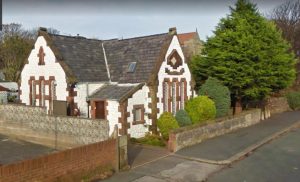
T. Bulmer & Co’s History, Topography and Directory of FURNESS & CARTMEL 1910.
OLD BARROW
Now the scene of busy life and activity, was, until 1860, a well-defined island, separated from the mainland by a narrow channel fordable at low water; but the erstwhile pebbly strand is now covered with warehouses, workshops, and business premises, and the narrow channel has been converted into a splendid system of docks. This island was formerly the property of the Michaelson family, into whose possession it came, by marriage, about the year 1700. It became the family residence in 1726, about which time the present hall was built, and continued in their occupation until 1863, when the property was sold to the Railway Company by Mrs. Michaelson. The island is now covered with streets and houses, mostly in the Scotch style of flats.
According to the Dock Museum at Barrow Mrs. Michaelson sold Barrow Island to the Furness Railway in 1863.
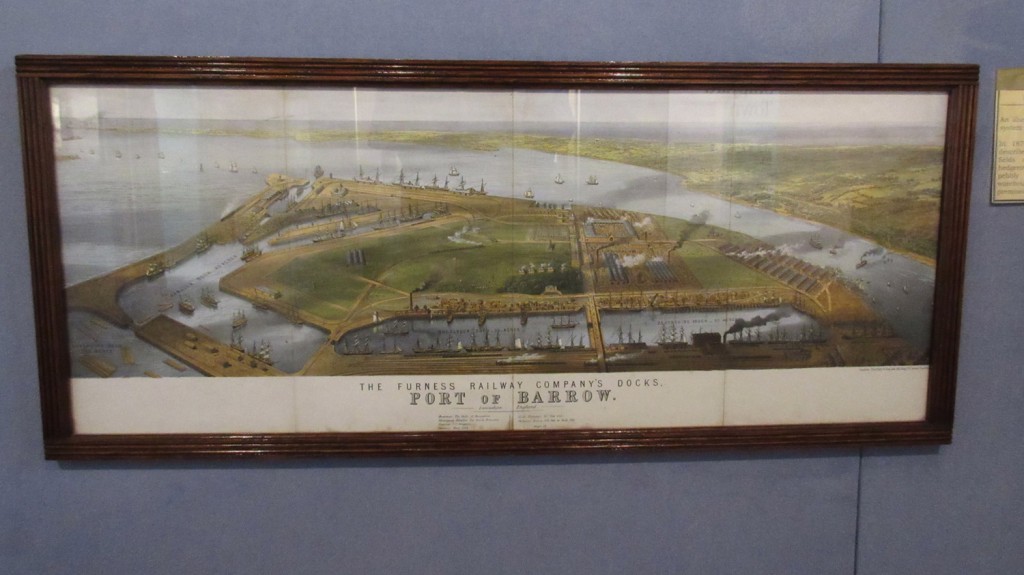
Barrow Shipbuilding Company, set up in 1871, took advantage of this available land and also the well-appointed docks. The mansion was demolished in shipyard expansion in 1915 but the Barrow Island farm building can still be seen.
GEORGE HERBERT MICHAELSON
Capt. George Herbert Michaelson married Sarah May Rachel Waller (b. 1857 Killeter, Co. Tyrone, died 1946) 2 December1880 at St. Columb’s Cathedral, Londonderry.
Banns: St Mary, Lancaster, Lancashire, England
George Herbert Michaelson – Bachelor, this parish
Sarah May Rachel Waller – Spinster, the parish of Templemore, Co. Londonderry
First Reading: 14 Nov 1880; Read By: William W. D. Firth
Second Reading: 21 Nov 1880; Read By: William W. D. Firth
Third Reading: 28 Nov 1880; Read By: C. H. Joberns
Notes: Married [written across entry]
Register: Banns 1880 – 1891, Page 5, Entry 10
Source: LDS Film 1526203
George was a military man, latterly a Major in the 27th Regiment of Foot (the Inniskilling Fusiliers). According to records “George Herbert Michaelson of Yewbarrow Cottage, Grange over Sands, a retired Major in HM Army formerly of High Street House, Lancaster afterwards of Cappy House, Tamlaght, Enniskillen died Jany 23 1896 Probate to Sarah Mary Rachel Michaelson Widow”.
(Great Western Railway shareholders 1835-1932 – Findmypast.co.uk)
There is an insight into his earlier career in other GWR shareholder record:-
“Great Western Railway shareholders 1835-1932
Registration of Probates and other documents
1880 Jany 3 John Haydock Gibson late of Bootham, York and of Lancaster Doctor of Medicine (Under £8000) died Decr 12 1879 Probate Decr 29 1879 Stock transmitted to Jane Michaelson Widow High Street House Lancaster
George Herbert Michaelson nephew of the said deceased an Executor named in the said Will in the event of his not being abroad at the time of the death of the said Testator being at such time a Captain in the 27th Regiment of Inniskillings of Her Majesty’s Army and quartered with his Regiment at Hong Kong in China.
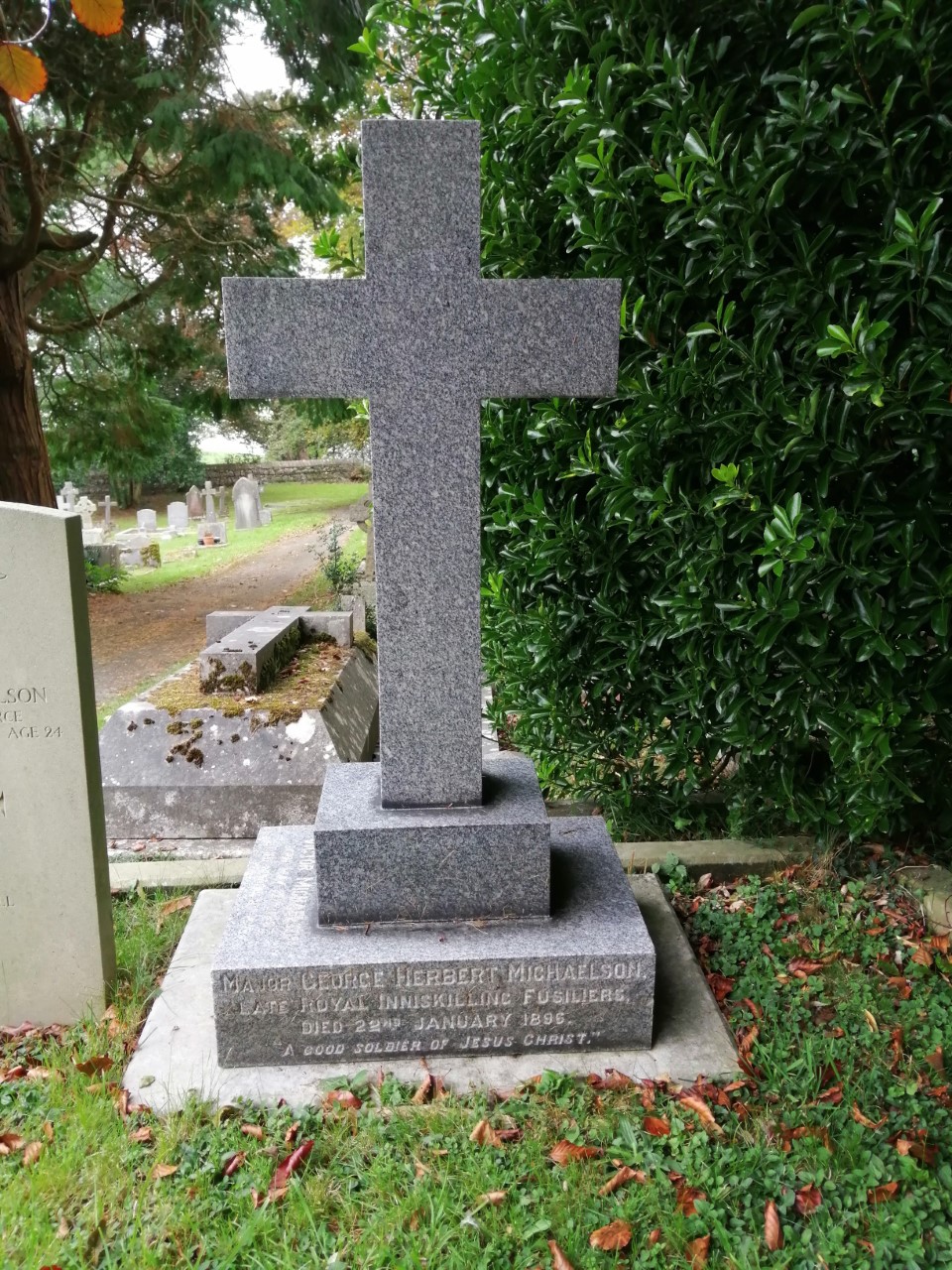
also, 1887 Jane Michaelson late of High Street House Lancaster Widow died July 31 1887 Probate Major George Herbert Michaelson Cappy House Tamlaght Enniskillen Ireland.”
CHARLES HERBERT MICHAELSON
Charles was admitted to Bedford Grammar School in September 1896, leaving in 1897. According to Admiralty records he entered the Royal Navy on the 15 Jan 1899; was a Lieutenant from 1 Apr 1905 and a Commander 31 Dec 1917.
Exeter and Plymouth Gazette 28 February 1905:
NAVAL AND MILITARY
The following appointments have been made at the Admiralty:-
Sub-Lieutenants J P Landon and C H Michaelson to the Prince George, 23rd inst.
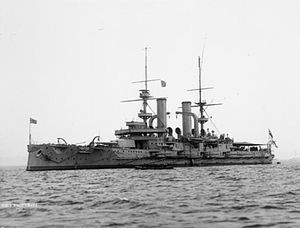
The 1911 Census records him on “His Majesty’s Ship Swiftsure, Commander John Henry Trye;
Charles Herbert Michaelson age 28 Single Lieutenant born Lancaster, Lancashire Church of England.”
Remarks from his navy records are interesting:
6 Jan 1918 Sat Ab Av Very steady, reliable & zealous. He has taken & has Proved himself a most trustworthy officer. Capt. Craig
7 Feb 1919 Sat Ab Av Draws well A very good Executive Officer Works hard Gets on very well with Officers & men has plenty of tact Capt. Vivian
7.10.19 Approved as a special case for a rank of Divisional Officer Belmullet being changed from Lt. Cdr to Cdr during Cdr Michaelson’s appointment C.G.
Placed on Retired List at own request 1.11. 22
Promoted to Capt retd 8.1.28
Consular Shipping adviser (NCS duties) San Francisco 22.8.39 to 3.12.39
Victory addl (not to join) 4.12.39 to 31.3.40
Reverts to Retired 1.4.40
Oct 13. endorse commendation by R. Ad. Bayly of Lt. Michaelson for jumping overboard to help the Comdr who was injured NC 2849/13
Some of the ships that he served on: Britannia, Crescent, Flora, Caesar, Prince George, Mars, Dominion, Cyclops, Swiftsure, Vindictive, Hindustan, Barham (Victory). He was present at the Battle of Jutland 31 May to 1 June 1916, whilst serving on HMS Barham the flagship of Rear-Admiral Hugh Evan-Thomas, commander of the 5th Battle Squadron, Captain Arthur William Craig.
Barham fired 337 fifteen-inch shells and 25 six-inch shells during the battle. The number of hits cannot be confirmed, but it is believed that she and Valiant made 23 or 24 hits between them, making them two of the most accurate warships in the British fleet. She was hit six times during the battle, five times by 30.5 cm shells and once by a 28.3 cm shell, suffering casualties of 26 killed and 46 wounded.
Barrow News 24/06/1916:
Lieut-Commander C H Michaelson, Royal Navy, HMS Barham, fought hard from the start in the Battle of Horn Reef (now generally known as Jutland), four officers and 23 men killed by enemy shell fire, engaged in spotting shots, article on pg 6
Royal Navy Officers Medal Roll: MICHAELSON Chas. H. Commr R.N. St V. B. “Colleen” – this indicates 1914-15 Star, Victory Medal and British War Medal.
Lancashire Daily Post 25 October 1929:
SCOUTS AND GUIDES, ANNUAL PRIZE DISTRIBUTION AT PRESTON
The Boy Scouts and Girl Guides of Preston and district assembled in force at the presentation of the year’s awards in Mill Hill Ragged School, last night, when the Mayor of Preston (Councillor W. Lucas) presided and Captain Michaelson, R.N., Commissioner for Training of North West Lancashire, handed over the trophies to the winners.
(continues) After presenting the trophies, Capt. Michaelson, Grange-over-Sands, congratulated the winners and gave a word of encouragement to the runners-up. If they had made a good show there was as much satisfaction to be got out of it as there was in winning. Making a good sporting effort was everything. He urged the Scouts to go in for the First Class Badge, and in that area they wished to raise the standard of First Class Scouts.
For their rally in June, at Blackpool, which would take place at a week-end, the presence of as many Scouts as possible was desired and they wanted them all to do something and not be mere spectators and to show by display, performance, and handicrafts that they were live Scouts in North-West Lancashire.”
Presentation by B-P of the Medal of Merit to Capt. Michaelson, Blackpool Rally 1930 (Photo courtesy Story of Scouting Museum)
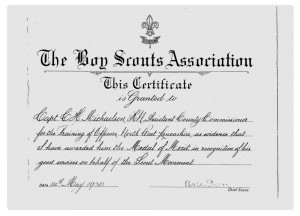
Capt. Michaelson, B-P, and C.C.
Lancashire Daily Post 30 May 1930:
LOCAL AND DISTRICT NEWS
Barrow St. George’s Church Scouts will go for their first week’s camping to Blakeholme Scout Camp, near Newby Bridge, where they will be under the supervision of Captain Michaelson, the Commissioner for North Lonsdale. For the second week those who are in the Guild will go to the Guild Camp at Troutbeck.
Lancashire Daily Post 23 November 1933:
NORTH-WEST SCOUTS RECORD
Council Meet at Lancaster
A MEETING of the North-West Lancashire County Boy Scouts’ Council was held at the Lancaster Town Hall last night, when Lieut.-General Sir Matthew H. G. Fell, of Ulverston, presided.
Those present included Lieut.-Colonel B. Paling Dobson, County Commissioner; Captain C. H. Michaelson, R.N., Assistant Commissioner for training; Mr. T. H. Blane, honorary treasurer; and Mr. L. Bennington, honorary secretary, with Mr. A. M. Chamberlain, Headquarters Travelling Commissioner.
A report was presented by Captain Michaelson on the training at Blakeholme Camp, and another by Mr. A. M. Chamberlain, the national organiser, who declared that the Boy Scout movement could touch a great many more people than it did at the present time.
Lancashire Daily Post 07 November 1934:
LANCASTER SCOUTS’ PROGRESS
(Report of the Annual meeting of the Lancaster Boy Scouts’ Association)
“Captain Michaelson, of the Blakeholme Scout Camp, said the time had come when they ought to take up the matter of Sea Scout groups and patrols on the North-west coast. The present position in the county needed some improvement.”
Fife Free Press, & Kirkcaldy Guardian 30 May 1936:
A NATIONAL WOODCRAFT CAMP FOR BOY SCOUTS
Great Tower Plantation, an estate consisting of 240 acres of beautiful woodland, on the borders of Lake Windermere, has been presented to the Boy Scouts’ Association by Mr. W. B. Wakefield, of the National Boys’ Department of the Y.M.C.A., and one of scouting’s earliest pioneers.
By his generous gift, one of the ambitions of the Boy Scouts’ Association – to have a national centre solely devoted to training in woodcraft and backwoodsmanship – has been realised.
The Great Tower Plantation will be available for camping this summer, but only applications from experienced Scouts will be entertained.
All applications should be made to the Verderer, Capt. C. H. Michaelson, R.N., Yewbarrow, Grange-over-Sands, Lancs.
Gloucester Journal 03 April 1937:
Great Tower Plantation
This will be a great year for camping at Great Tower Plantation, an estate consisting of 240 acres of beautiful woodland, on the borders of Lake Windermere, which was presented to the Boy Scouts’ Association last year by Mr. W. B. Wakefield, of the National Boys’ Department of the Y.M.C.A., and one of Scouting’s earliest pioneers.
There is much work to be done at the camp, especially in clearing away the dense undergrowth and making paths. The very wet winter has made progress difficult, but it has not deterred Verderer Captain C. H. Michaelson, R.N., and patrols of local Scouts from putting in much valuable work.
The greatest thrill most boys will get will be in preparing one of the finest camping grounds in the country; and adventure too, for everything is so natural, so untouched, that to them it will be like walking into a jungle where they will have to make a clearing to pitch their tents.
Scouts who go to Great Tower do not have the idea of going for a lazy holiday; the one object of the camp is to train Scouts for pioneering and backwoodsmanship, and Great Tower offers one of the finest opportunities for such a life.
The camp was officially opened by the Chief Scout in August last year, and even before it was opened applications for camping came from as far as Uxbridge, Epping Forest, Sheffield and Wellingborough.
Not only will the camp set a great example for Scouting, but offers excellent opportunities for hiking. Applications from Scoutmasters who wish to take parties of Scouts to Great Tower should be made to the Verderer, Captain C. H. Michaelson, R.N., Grange-over-Sands, Lancs.
There is more information here about the opening of GT from the Barrow News, 22nd August 1936 and
from ‘The Scout’ magazine (courtesy of Story of Scouting Museum) :-
Footnote: Talking to a colleague at the City Museum, Lancaster today (23 Jan 2016) it transpired that her father John Anthony (Jack) Johnson was at GT on the day and was delegated a vital task. Jack, born 1918 in Barrow, was a King’s Scout at St. John’s Church Troop, and along with a mate, another King’s Scout, they were charged with cycling down to Newby Bridge there to meet B-P’s car and escort him up to the camp.
Jack recalls having to speed along on his bike with the car in close pursuit up and along the steep road all the way to the camp. (ASH)
The photo below is in the leaders’ room at Waddecar and presumably shows members of one of Capt. Michaelson’s Wood Badge Courses. It was possibly taken at Great Tower. The date is unknown but Charles Joseph Kinleside (mentioned) was born in 1903 in Newcastle (died 1963), so perhaps it was in the early 1940’s.
Westmorland Gazette 9 April 1949:
LOSS TO SCOUT MOVEMENT
Death of Captain C. H. Michaelson
The funeral took place at Grange, on Tuesday, of Capt. Charles H. Michaelson, R.N., Great Tower, Windermere, an enthusiastic leader of the Boy Scout movement, who died at the age of 66 years. The coffin was draped with the flag from H.M.S. Barham *see note below*, the flag-ship on which he served during the Battle of Jutland. Members of the local branch of the British Legion acted as bearers, and a guard of honour was formed by members of the staff of Great Tower.
At the graveside Capt. Michaelson’s cap and sword were received by the Scouts, representatives being present from Barrow, Morecambe, Blackpool, Leyland and Ulverston.
Capt. Michaelson was the last surviving grandson of one of the earliest settlers in Barrow, who once owned Barrow Island. It was only a few weeks ago that Capt. Michaelson and his sisters gave four pictures of this early pioneer, and of Barrow Island, to the Barrow Museum and Committee.
He was the only surviving son of the late Mr. and Mrs. Michaelson, Yewbarrow, Grange, and his mother pre-deceased him a short time ago at the age of 91 years.
Entering the Royal Navy at an early age he served all over the world, and, although, retired, he was recalled for special service at the begining of the last war.
With his death the Boy Scout movement has lost one of its greatest supporters, for since his retirement he had devoted his life to this organisation. He lived at Great Tower, Windermere, the permanent Scout camp given to the movement by the Wakefield family, which was opened by the late Lord Baden Powell.
Capt. Michaelson is survived by two sisters, one of whom is Mrs. Eden Smith, Grange.
England & Wales Government Probate Death Index:
MICHAELSON Charles Herbert of Great Tower Windermere Westmorland died 2 April 1949 Probate Lancaster 3 September to Neville Lister Eden-Smith engineer and William James Parker boy scouts association warden. Effects £6934 7s. 2d.
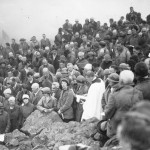
** I think it is reasonable to assume that, considering Capt. Michaelson’s family connections (see below), this is the same flag that was used when the FRCC war memorial on Great Gable was unveiled on June 8th, 1924.
“UNVEILING THE WAR MEMORIAL TABLET
Great Gable, June 8th, 1924
W. T. PALMER
On Whit Sunday the Club completed its task of a permanent and magnificent memorial to members who fell in the Great War. In October, 1923, the title-deeds of 3,000 acres of high mountain had been handed over to the National Trust. The rocks, buttresses, and recesses of Lingmell, Great End, Allan Crags, Green Gable, Great Gable, Kirkfell and other peaks east and west of Sty Head Pass had been secured, as Dr. Wakefield (the new President) declared, ‘to us and our children for ever.’
The occasion at Coniston was historic. The next ceremony on Great Gable was more intimate. If there is any communion with the spirits of dead warriors, surely they were very near that silent throng of climbers, hill-walkers, and dalesfolk who assembled in soft rain and rolling mist on the high crest of Great Gable. The gloom and gentle wind-sounds added impressiveness to the occasion. There was no effort at pageantry or emotion; the service was a tribute to memory.
The simple eloquence of Arthur Wakefield, the glowing eulogy of Geoffrey Winthorp Young, the calm confidence of the prayers recited by the Rev. J. H. Smith, added to the striking power of the occasion. No one, however dour and hardened, passed through the service on Great Gable on that memorable day without feeling touched, but never was there unrelieved sadness in heart or mind.
The war-stained Union Jack which flew from H.M.S. Barham at the battle of Jutland, and which at the outset enshrouded the bronze tablet, gave the only touch of colour.
For the rest, the climbers came in well-worn grey and brown. Now and again, through the hush, came the clink of boot-nails on the boulders, or a word of softly spoken greeting. Grey mists and drifting rain gave us once more a mountain greeting.”
From the Journal of the Fell & Rock Climbing Club of the English Lake District.
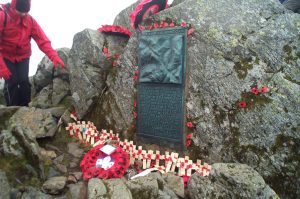
The Scouter, June 1949:
THE OUTLOOK
By THE CHIEF SCOUT
IT was with great regret that I heard that Captain Michaelson had been called to Higher Service. He was one of those men whose heart and soul were bound up in the Movement and his influence as Assistant County Commissioner for Training in North-West Lancs., as Warden of Blakeholme, and finally, since 1936, of Great Tower cannot easily be estimated. He had for long been a sick man, but nothing would daunt him. His supervision of Patrol camping at Great Tower gave many a Patrol Leader a vision of what he could do and the inspiration to do it. The standards he set were always of the highest, and he was never willing to tolerate slipshod camping, although always sympathetic and helpful to those who were really trying. A great Scout, the effect of whose work will be felt for many years to come.
HMS Barham
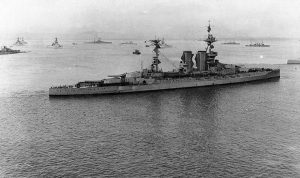
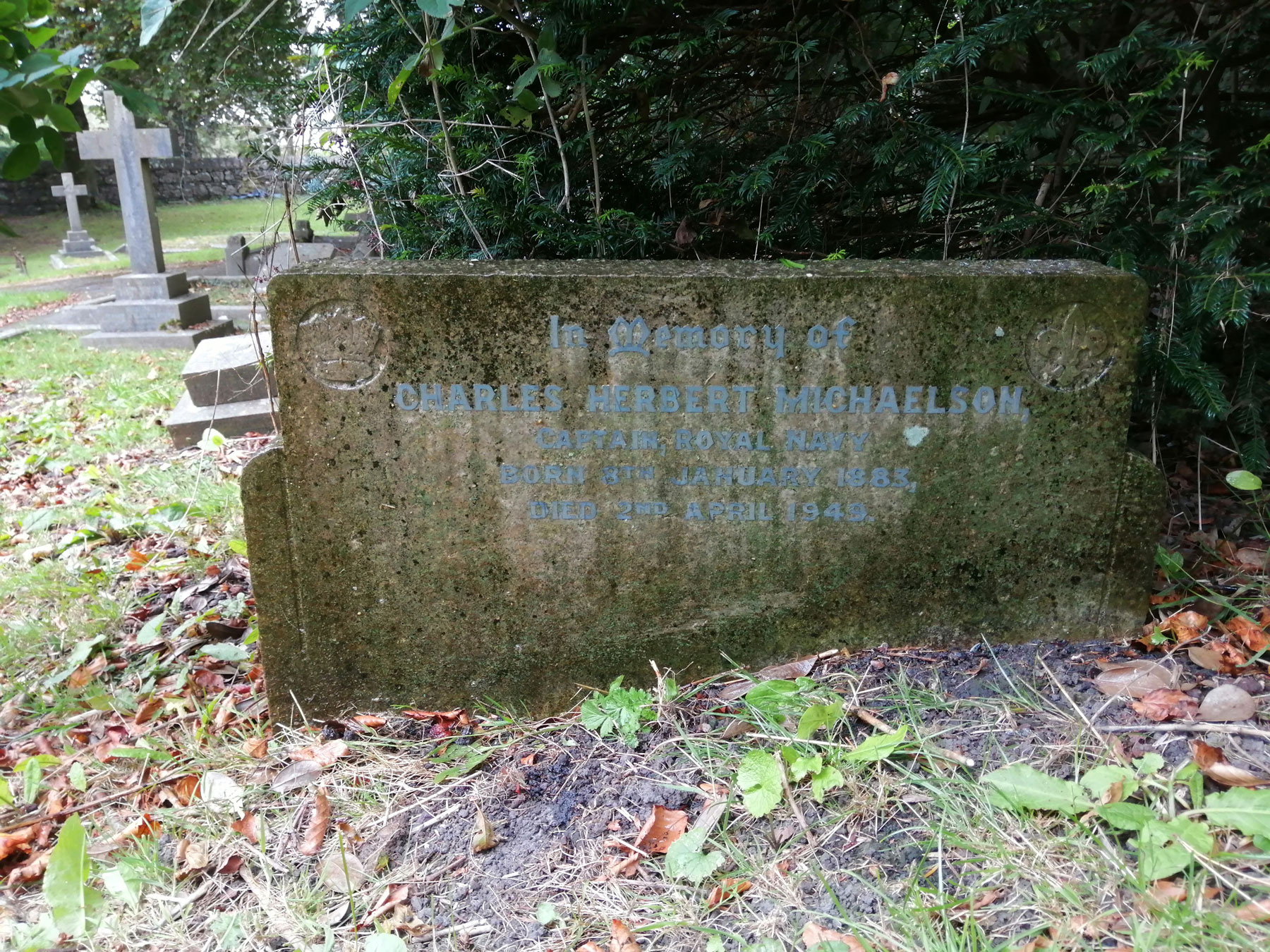
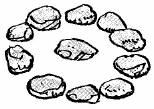
BLANCHE MICHAELSON EDEN SMITH
Mrs. Eden Smith, mentioned above, was Charles’ sister Blanche born 13 September 1881 in Hong Kong. Blanche married Henry Eden Smith (1864-1940) in 1902. In 1911 they were living at Andyfield, Grange. Henry, who was President of Grange over Sands & District Boy Scouts’ Association, Chairman of Grange Urban District Council, Chairman of the North Lonsdale Education Committee, Hon. Sec. of Grange Amateur Operatic Society and North Lonsdale Lawn Tennis Club and a J.P., died 1 May 1940 at a Middlesex hospital.
Blanche was a member of the Fell & Rock Climbing Club and is listed in several editions of their journal as a member of the Committee. She also co-authored several Lake District climbing guides.
She was also a founder member of the Pinnacle Club (1921) – A UK based club of women climbers who are united by a shared enthusiasm for climbing.
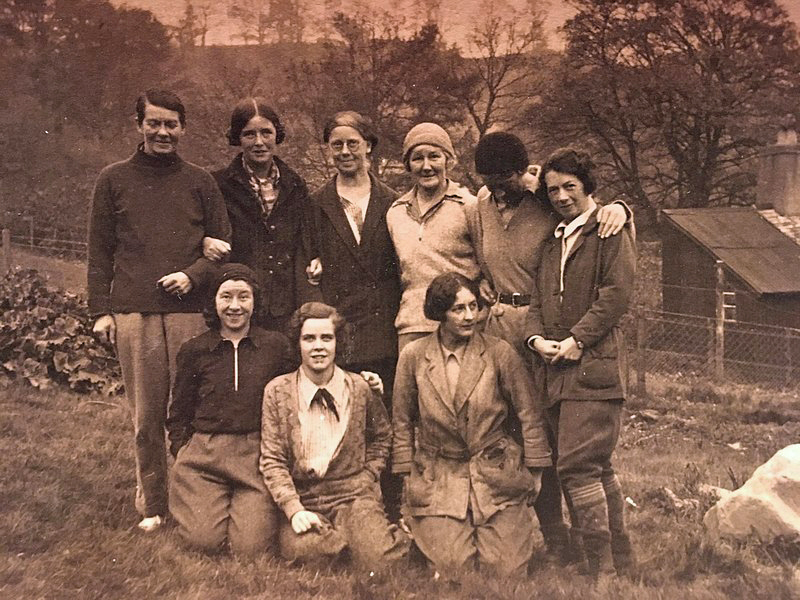
THE JOURNAL OF THE FELL & ROCK CLIMBING CLUB OF THE ENGLISH LAKE DISTRICT
Edited by A. E. WORMELI.
No. 57 VOLUME XX (No. I)
Published by THE FELL & ROCK CLIMBING CLUB OF THE ENGLISH LAKE DISTRICT
1963
IN MEMORIUM
MRS. B. EDEN-SMITH 1919-63
Before joining the Club in 1919 it would appear that Mrs. Eden-Smith had little or no interest in either fellwalking or rock-climbing. Her ‘sporting’ instinct, due no doubt to the Irish blood in her, seems to have found an outlet in horseriding, motor-cycling, lawn tennis, hockey (County player) as well as cricket, at which game she could bowl a good length and stylishly handle a bat. She was especially fond of swimming (continued into her seventies) and once swam across Windermere Lake from Lowood. In contrast, she loved music, and was a capable violinist.
Naturally, such a superbly fit person took to the new sport like a duck to water, and, as far as I know, Mrs. Eden-Smith was never found wanting when participating in fell-walking or rock-climbing. It was a delight to see her lissom figure moving gracefully on the hills and one could not fail to admire her stamina, which seemed never to flag even on the longest day.
In this respect I particularly recall a day in the Scottish Highlands when we bagged fifteen tops and ascended nearly 8,000 feet in less than ten hours. Her power of endurance was put to a more severe test on a similar excursion, when, owing to heavy rain that had persisted all day we had to wade across a swollen Dee in order to reach headquarters that night. It needed considerable courage to take the plunge, but fortunately for us, perhaps, the danger was lessened by the presence of two small islets (barely awash) in mid-stream and a judicious use of these proved of great assistance in our struggle across the torrent.
This readiness to face any risk was also exemplified when she and I made the first ascent of Moss Ghyll Grooves. In order that the leader might avoid a run-out of about 80 feet (from the Oval to the Lookout) she undertook a precarious and belay-less stance some 15 feet higher, thereby boosting the morale of the leader. How much easier it was, with someone at hand, to take that delicate step across to the Pedestal !
However, adventures of this kind did not affect her innate modesty—one of her characteristics. Perhaps graciousness was her outstanding quality and it won over all those with whom she came in contact.
It is sad to relate that one hitherto so active and companionable should be laid low (by reason of a leg amputation) for the last six months of life, during which period she had the further distressing experience of losing her son. It seemed that fate was cruel towards the end, but her trials were borne with fortitude. Mrs. Eden-Smith leaves a memory of bright companionship for those who were privileged to become acquainted with her through the medium of the hills.
H. M. KELLY
The Coniston Tigers by Arthur Harold Griffin (2000)
” Several times I was fortunate enough to be invited to tie on to the ropes of people doing the easier routes and very soon I acquired a rough, working knowledge of the crag, and, perhaps, some slight competence about the game – at least in the lower grades. After all these years I’m sorry I can remember the name of only one of these very kind people – probably because she took me up climbs on two or three occasions. She was Mrs Blanche Eden-Smith, who had been the great H.M. (Harry) Kelly’s partner on many famous first ascents, including that of Moss Ghyll Grooves on Scafell in 1926. I remember her with gratitude as a nimble, boyish figure, very friendly and helpful to a novice. She introduced me, I remember, to several of her friends, and when-ever we met she was always interested in my progress.”
On the Roof of the World
By Richard Nelsson
” 1980 Hundreds of climbers who take to the Lakes and Peak over the Easter weekend will be following in the footsteps of one of the greatest climbers of all time, the legendary H. M. Kelly, who has died at the age of 96. His ascent of Moss Ghyll Grooves on Scafell in the 1920’s was described as ‘like the firing of a fuse to explode the latent energies of England’s rock climbing youth’.
A glimmer of the rewards he found in climbing comes in his summing up of the Moss Ghyll Grooves ascent, which he made with Mrs Eden-Smith of Grange and a young but inexperienced climber, J.B. Kilshaw.
Bowfell Buttress
Page: 288
The Plaque Route 90m D
Note; Pitches 5 and 6 were destroyed by Rockfall some years ago, the description is here for the record.
First ascent: (30/04/1931) H M Kelly, Blanche Eden-Smith

